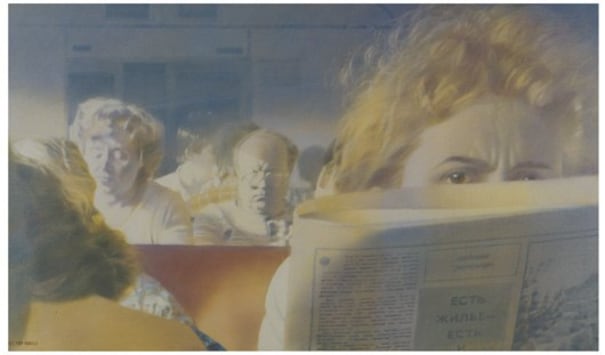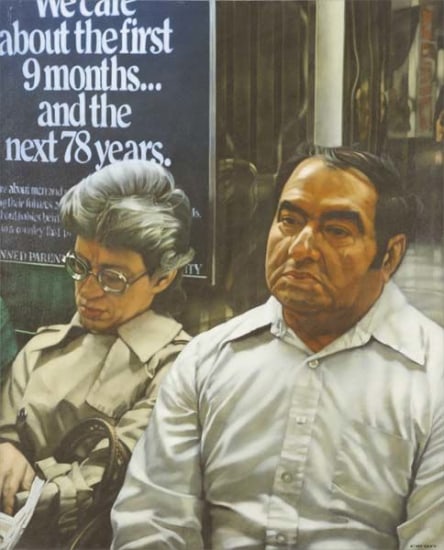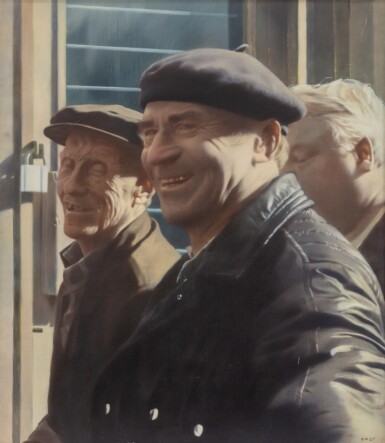Semyon Faibisovich The Vodka Line Series 1990 Oil on canvas. 188 x 284.5 cm (74 x 112 in). Initialled in Cyrillic and dated ‘SF 90’ lower right; signed, titled and dated ‘Semyon Faibisovich The Vodka Line Series 1990’ on the reverse.
Provenance Private Collection, Europe Exhibited New York, Phyllis Kind Gallery, Semyon Faibisovich, 1990; New York, Museum of the Yeshiva University, Remembrance: Russian Post-Modern Nostalgia, 10 September 2003 – 2 February 2004; London Haunch of Venison, Glasnost: Soviet Non-Conformist Art from the 1980s, 16 April–23 June 2010 Literature S. Faibisovich, ed., Semyon Faibisovich: Art of the 1980s, Moscow, 2001, p. 31 (illustrated in colour); Remembrance: Russian Post-Modern Nostalgia, exh. cat., Museum of the Yeshiva University, New York, 2003, p. 133 (illustrated in colour); Glasnost: Soviet Non-Conformist Art from the 1980s, exh. cat., Haunch of Venison, London, 2010, pp. 106–07 (illustrated in colour) Catalogue Essay Painted in 1990, this work depicts an ordinary Soviet scene of everyday life, a typical subject in the oeuvre of the internationally renowned Russian ‘unofficial’ artist Semyon Faibisovich. The artist chooses to act as an observer of Russian society and creates symbolic work that is socially critical, subtly ironic and contemplative. Ilya Kabakov describes the origins of unofficial Russian art as “an attempt to express the ‘powerless existence that overwhelmed us all’ by finding the means of reference to the content of our lives and to artistic form.” (Olga Sviblova, ‘Soviet Non-Conformist Art of the 1980s: Strategy of Approach’, Glasnost: Soviet Non-Conformist Art from the 1980s, London: Haunch of Venison, p. 25) The work here depicts a scene in motion, a group of ordinary people waiting in line for vodka – a common sight in Soviet times, when queuing was an integral part of everyday life. The composition consists of mainly men and the occasional woman, portrayed with strained facial expressions and focused body language. The artist raises issues of social alienation by exploring a subject that is familiar but which also exposes the hardship of life. The muted colour palette he has chosen conveys the painting’s grim mood and, in turn, can be extrapolated to the social atmosphere of the times it is referring to. The artist describes his discovery of the true nature of Soviet existence – a revelation which caused him start painting – as a “beautiful nightmare, resonating in my soul with a heartbreaking mixture of hatred, pity and elation.” (Vladimir Paperny, ‘Sots-Art, Socrates, a Rabbit, and a Python’, Semion Faibisovich: Painting from the 1980s, Moscow: Regina Gallery, p.33) The influence of 1960s American photorealism is evident in the artist’s work. Like Richard Estes who painted from photographs of New York’s street life, and Gerhard Richter who famously assembled the Atlas collection of newspaper clippings and photographs to use as source material for his photo-based paintings, Faibisovich uses snapshots captured by camera as the basis for his work. His friend, the Russian poet and essayist Mikhail Aizenberg, has praised Faibisovich for a unique vision that allows him to pick out subjects which would escape the attention of others, and for the gift of reflexivity which enables him to successfully combine direct visual experience with his personal perception of it. By recording the reality of vodka and sausage lines, demonstrations, the elderly, train passengers and what he himself calls the “depressing material of everyday life”, Faibisovich invites contemplation of both social and political existence in Soviet society. Read More
Semyon Faibisovich The Vodka Line Series 1990 Oil on canvas. 188 x 284.5 cm (74 x 112 in). Initialled in Cyrillic and dated ‘SF 90’ lower right; signed, titled and dated ‘Semyon Faibisovich The Vodka Line Series 1990’ on the reverse.
Provenance Private Collection, Europe Exhibited New York, Phyllis Kind Gallery, Semyon Faibisovich, 1990; New York, Museum of the Yeshiva University, Remembrance: Russian Post-Modern Nostalgia, 10 September 2003 – 2 February 2004; London Haunch of Venison, Glasnost: Soviet Non-Conformist Art from the 1980s, 16 April–23 June 2010 Literature S. Faibisovich, ed., Semyon Faibisovich: Art of the 1980s, Moscow, 2001, p. 31 (illustrated in colour); Remembrance: Russian Post-Modern Nostalgia, exh. cat., Museum of the Yeshiva University, New York, 2003, p. 133 (illustrated in colour); Glasnost: Soviet Non-Conformist Art from the 1980s, exh. cat., Haunch of Venison, London, 2010, pp. 106–07 (illustrated in colour) Catalogue Essay Painted in 1990, this work depicts an ordinary Soviet scene of everyday life, a typical subject in the oeuvre of the internationally renowned Russian ‘unofficial’ artist Semyon Faibisovich. The artist chooses to act as an observer of Russian society and creates symbolic work that is socially critical, subtly ironic and contemplative. Ilya Kabakov describes the origins of unofficial Russian art as “an attempt to express the ‘powerless existence that overwhelmed us all’ by finding the means of reference to the content of our lives and to artistic form.” (Olga Sviblova, ‘Soviet Non-Conformist Art of the 1980s: Strategy of Approach’, Glasnost: Soviet Non-Conformist Art from the 1980s, London: Haunch of Venison, p. 25) The work here depicts a scene in motion, a group of ordinary people waiting in line for vodka – a common sight in Soviet times, when queuing was an integral part of everyday life. The composition consists of mainly men and the occasional woman, portrayed with strained facial expressions and focused body language. The artist raises issues of social alienation by exploring a subject that is familiar but which also exposes the hardship of life. The muted colour palette he has chosen conveys the painting’s grim mood and, in turn, can be extrapolated to the social atmosphere of the times it is referring to. The artist describes his discovery of the true nature of Soviet existence – a revelation which caused him start painting – as a “beautiful nightmare, resonating in my soul with a heartbreaking mixture of hatred, pity and elation.” (Vladimir Paperny, ‘Sots-Art, Socrates, a Rabbit, and a Python’, Semion Faibisovich: Painting from the 1980s, Moscow: Regina Gallery, p.33) The influence of 1960s American photorealism is evident in the artist’s work. Like Richard Estes who painted from photographs of New York’s street life, and Gerhard Richter who famously assembled the Atlas collection of newspaper clippings and photographs to use as source material for his photo-based paintings, Faibisovich uses snapshots captured by camera as the basis for his work. His friend, the Russian poet and essayist Mikhail Aizenberg, has praised Faibisovich for a unique vision that allows him to pick out subjects which would escape the attention of others, and for the gift of reflexivity which enables him to successfully combine direct visual experience with his personal perception of it. By recording the reality of vodka and sausage lines, demonstrations, the elderly, train passengers and what he himself calls the “depressing material of everyday life”, Faibisovich invites contemplation of both social and political existence in Soviet society. Read More












Testen Sie LotSearch und seine Premium-Features 7 Tage - ohne Kosten!
Lassen Sie sich automatisch über neue Objekte in kommenden Auktionen benachrichtigen.
Suchauftrag anlegen